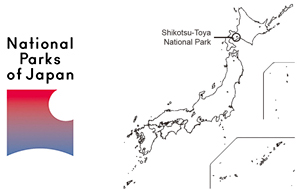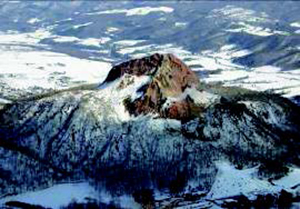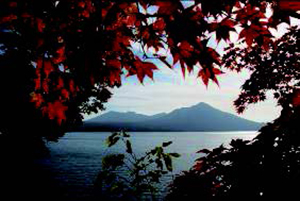National Parks of Japan
Shikotsu-Toya National Park
Live volcanoes and quiet blue lakes —a museum of volcanic activity

Location of Shikotsu-Toya National Park
 Mt. Showa Shinzan: a volcano that emerged from a barley field
Mt. Showa Shinzan: a volcano that emerged from a barley field Lake Shikotsu: A deep lake with strong connections to human life
Lake Shikotsu: A deep lake with strong connections to human lifeShikotsu-Toya National Park is well known for its caldera lakes and volcanic peaks. More than any other national parks in Hokkaido, here people lead their lives in close contact with nature. Life has gone on for ages, older than the volcanoes, younger than the deep lakes.
A volcano emerges from a barley field
The exquisite natural environment of Shikotsu- Toya National Park includes the smoking volcanic peaks of Mt. Usu and Mt. Eniwatake, the beautiful free-standing Mt. Yotei, and the mountains of Sapporo, enveloped by thick forests over the ages. The park features volcanic landscapes of hot springs and steamy jigokudani (fumarolic areas), but one of its most impressive sights is Mt. Showa Shinzan (literally, “new mountain in Showa Period”).
Mt. Showa Shinzan is an extraordinary volcano that abruptly surged up from what was once a flat barley field during a two-year eruption (1943-1945). What is more, the volcano’s birth and growth were recorded in detail by a postal worker. The account that he left behind is known as “The Mimatsu Diagram”, and it has become an important record for the world.
Human life and the lake
Human history cannot be left out when describing the Shikotsu-Toya National Park. The deep forests and lakes have stood alongside villages and cities throughout history, watching over people’s lives and the ways of nature.
In Ainu mythology, a story has been passed down of a god so huge he could walk across the oceans. When one day the god decided to test the depth of Lake Shikotsu, he was surprised that the water came up to his hips. The depth of the lake revealed in the myth tells us that the lake was closely connected to people’s lives long ago.
In the early modern period, a multitude of people including the descendants of SAMURAI settled in Hokkaido. At the time, mines and hydroelectric power plants thrived in the town near Lake Shikotsu, but it was still a very remote area with difficult access by a small steam locomotive.
70th anniversary: heading into the future
On 16 May 2019, the Shikotsu-Toya National Park marked the 70th anniversary of its designation as a national park. With its volcanoes, lakes and rich nature, the park continues to draw tourists to see its sights. From its hot springs and steaming hot swamps, visitors can feel the energy emanating from the young volcanoes. Divers in Lake Shikotsu can sense the depth that amazed even the Ainu god. The straight road, remaining since the times of modern settlement, could lead you into this land of mystery, as it has led travelers in years past.
The Shikotsu-Toya National Park will continue to be a place where humans and nature coexist.
Ministry of the Environment: Shikotsu-Toya National Park website
http://www.env.go.jp/en/nature/nps/park/shikotsu/index.html



